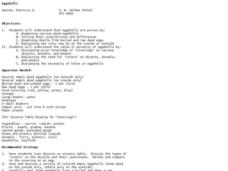Curated OER
It's The States of Matter
Students investigate the properties of solids, liquids and gases. In this states of matter lesson plan, students observe dry ice and its characteristics. They calculate the density of dry ice and observe the sublimation of the dry ice...
Curated OER
Can Acids and Bases Remedy the Body?
Students try to cure an upset stomach. For this acids and bases in the body lesson, students create a upset stomach with a vinegar and water solution, then use antacids and home remedies to attempt to restore pH balance to the mixture.
Curated OER
Chromatography - Chemical Separation of Colors
Third graders use the scientific method as they separate the colors used in ink. In this chromatography lesson, the teacher introduces students to how chromatography is used in several careers, then students perform an experiment to see...
Curated OER
Eggshells
Students examine the porosity of eggshells. In this eggshell properties lesson, students observe dyed eggs, then peel the eggs to see if the color was able to go through the shell and discuss why eggshells have pores.
Curated OER
Density
Students find the mass, volume, and density of various objects. For this density measurement lesson, students observe how same-sized objects can have different masses, then use water displacement to find the density of each object and...
Curated OER
Density - An Introduction
Students experiment with objects of different densities. In this density lesson, students examine same-sized objects with different weights, then look at a teacher explanation of density. Students make wave bottles and a density jar to...
Curated OER
Changing States of Matter
In this recognizing how states of matter change instructional activity, students use words from the word bank to fill in the missing words to describe how water changes to steam and ice and how steam and ice change to form water....
Curated OER
Making Mayonnaise - An Edible Emulsion
Students find a way to mix oil and water. In this emulsion lesson, students attempt to mix oil and water, then add egg yolk to the mixture to serve as an emulsifier and observe the results.
Curated OER
Air Pressure
Students examine air pressure. In this air pressure lesson, students perform a series of experiments to evaluate the effects of air pressure.
Curated OER
Amazing Salt
Students examine the effects of salt on ice. In this salt lesson, students observe what happens to the temperature of ice when salt is added, then make ice cream to see how this knowledge can be used.
Curated OER
Polymers: The Discovery
Students examine various polymers. In this polymers lesson, students perform three experiments with polymers to identify them and observe their interesting properties.
Curated OER
Light and Dark
For this recognizing things that provide light worksheet, students cut out only the pictures that give off light and paste them in order from brightest to least bright. Students show 4 answers.
Curated OER
Diffusion of Molecules
Students conduct a series of experiments to observe factors that impact molecular movement. In this molecular chemistry lesson plan, students drop food coloring in water with different properties (hot, with ice, with alcohol) and observe...
Curated OER
How Strong is the Solution
Students investigate the strength of solutions. For this scientific inquiry lesson plan, students examine various solutions of food color and water as they discover the concentration of the solutions by adding bleach to clear the color.
Curated OER
Diffusion Through Balloons
Students observe the diffusion of air molecules through a balloon. In this chemistry and molecules lesson, students fill balloons with air and a scented substance and observe whether the scented air is able to permeate the balloon.
Curated OER
Acid Rain Environment Pollution
Learners combine different materials to create chemical reactions. In this chemical reaction lesson plan, students will combine different materials to create chemical reactions and define these results as acids or bases. They will also...
Curated OER
Oxidation: How Can It Be Proved?
Students explore the process of oxidation. In this lesson about oxidation, students observe four different demonstrations. Students watch examples of oxidation in order to understand the process. Students discuss the chemical reactions...
Curated OER
Strings and Things: An Investigation into pH
Students test the pH of everyday substances. For this chemistry lesson, students test the pH of household substances using litmus paper to classify substances as acids or bases, then use pH to test the validity of the claim that dock...
Curated OER
What is Made From Plastic?
In this what is made from plastic worksheet, students identify items made from plastic and illustrate them. Students fill five boxes with drawings of items made from plastic.
Curated OER
Materials Crossword (1)
In this materials crossword puzzle worksheet, students read clues of specific items and use the word bank to answer which types of materials the items are usually made from. Students write nine answers.
Curated OER
Things Made From Fabric
In this identifying things made from fabric worksheet, students identify and illustrate items made from fabric. Students draw five items made from fabric.
Curated OER
What Is Made From Metal?
In this what is made from metal worksheet, students identify and illustrate items made from metal. Students draw four pictures.
Curated OER
The Effect of Temperature on Solubility
In this solubility worksheet, students conduct an experiment to see how temperature effects the solubility of salt in water. Students record their data in a chart and then graph the results. Then students complete 2 short answer questions.
Curated OER
Hunting for Aqueous Solutions
For this aqueous solutions worksheet, students will conduct an experiment to determine the solubility of different common kitchen items. Students then complete 3 short answer questions.

























